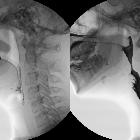Loeys-Dietz syndrome

Loeys-Dietz syndrome is an autosomal dominant connective tissue disorder which has many features similar to Marfan syndrome.
The disease is characterized by skeletal manifestations and vasculopathies. Although Loeys-Dietz syndrome shares many similarities with Marfan syndrome, the course is often more aggressive with respect to vasculopathy and is more likely to affect peripheral arteries.
The classical triad of Loeys-Dietz syndrome is described as :
- arterial tortuosity and aneurysms
- hypertelorism
- bifid uvula or cleft palate
Epidemiology
Loeys-Dietz syndrome is rare, with prevalence estimated at less than one per 100,000.
Clinical presentation
Disease spectrum and associated features include:
Craniofacial
- hypertelorism
- cleft palate
- bifid uvula
- craniosynostosis
- malar hypoplasia
- blue sclerae
- Chiari I malformation
- hydrocephalus
Cardiovascular
- aortic dissection
- aortic dilatation
- non-aortic aneurysms (a distinguishing feature of Loeys-Dietz syndrome), including:
- popliteal artery aneurysm
- internal thoracic artery aneurysm
- common iliac aneurysm
- splenic artery aneurysm
- intracranial aneurysm
- arterial tortuosity
- associated congenital cardiac abnormalities:
- mitral valve prolapse
- left ventricular hypertrophy
Musculoskeletal
- arachnodactyly
- camptodactyly
- pectus carinatum
- scoliosis
- talipes equinovarus
- joint laxity
- dolichostenomelia (unusually long limbs)
- cervical spine instability
Other
- developmental delay
- environmental allergies
- dural ectasia
Pathology
It is caused by mutations in the genes encoding transforming growth factor-beta receptor 1 (TGFBR1) or 2 (TGFBR2). Although Loeys-Dietz syndrome is inherited in an autosomal dominant pattern, de novo mutations account for approximately 75% of cases.
Subtypes
Loeys-Dietz syndrome can be subdivided into four subtypes depending on their genetic mutations and resulting phenotypic features.
- type I: predominantly craniofacial features
- TGFBR1 mutation; chromosome 9q22
- type II: predominantly cutaneous features
- TGFBR2 mutation; chromosome 3p22
- type III: predominantly aneurysm-osteoarthritis features
- SMAD3 mutation; chromosome 15q
- type IV: predominantly Marfanoid features
- TGFB2 mutation; chromosome 1q41
Radiographic features
Please refer to individual articles for the respective characteristics.
History and etymology
It is named after Harry C Dietz, an American physician, and Bart L Loeys, a Belgian physician.
Siehe auch:
und weiter:

 Assoziationen und Differentialdiagnosen zu Loeys-Dietz-Syndrom:
Assoziationen und Differentialdiagnosen zu Loeys-Dietz-Syndrom:


